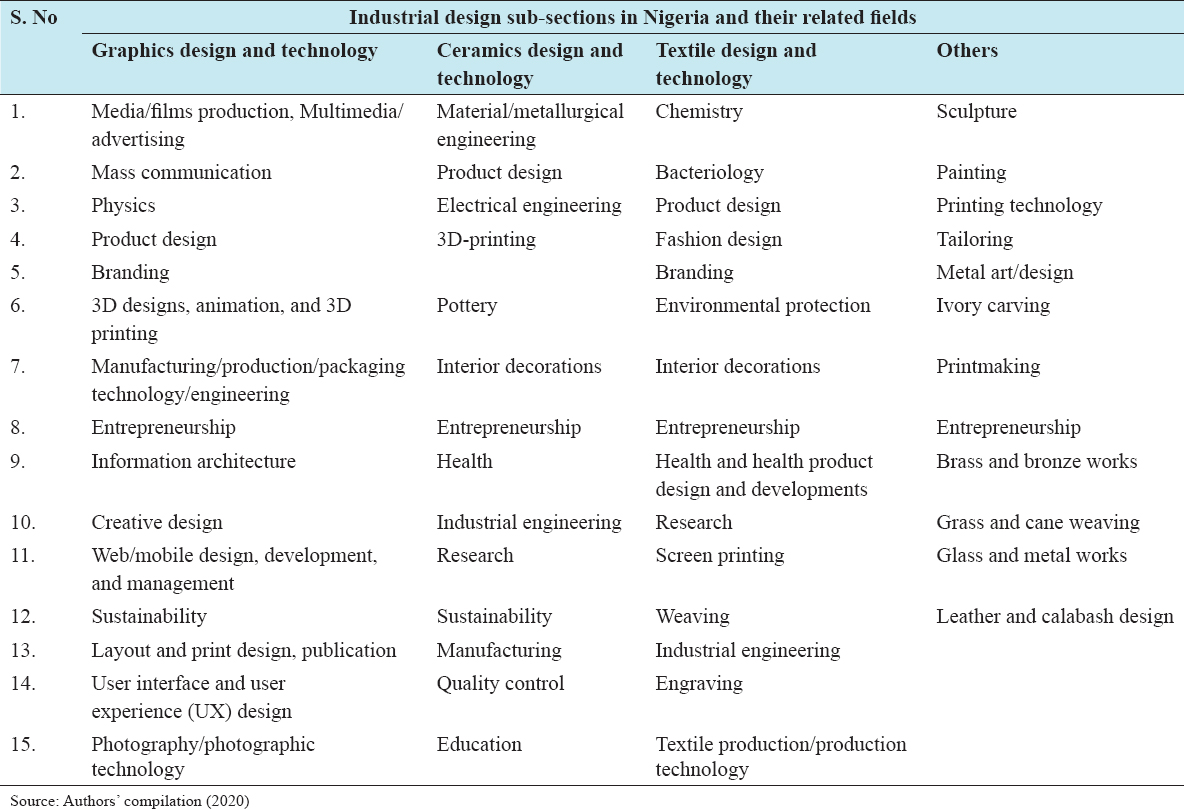REFERENCES
1. Kashim IB. Visual and Material Culture in the Context of Industrial Design:The Contemporary Nigerian Experience. London:IntechOpen;2013. 223-42.
2. Dumas A. Theory and Practice of Industrial Design;2000. Available from:http://www.urenio.org/tools/en/industrial_design.pdf. [Last accessed on 2020 Jun 23].
3. Brian P. Art vs. Graphic Design;2011. Available from:https://www.buchtelite.com/7040/arts_entertainment/art-vs-graphic-design. [Last accessed on 2020 May 26].
4. Bye E. A direction for clothing and textile design research. Cloth Text Res J 2010;1:1-13.
5. Heskett J. Industrial Design (World of Art Series). New York:W. W. Norton and Company;1980.
6. Ogunduyile SR, Akinbogun TL. Industrial Design Status and the Challenges to National Development in NIGERIA, Presentation to The SABS Design for Development Lekgotla;2006.
7. Akintayo WL, Abiodun B. State of town and gown in nigerian educational system with emphasis on industrial arts and design (1975-2012). Singaporean J Bus Econ Manag Stud 2013;2:87-100.
8. Sale P, Maiwada S, Ahuwan AM, Aboderin AO. A study of the organisational input into the industrial design postgraduate programme of Ahmadu Bello University, Zaria. Arts Des Stud 2015;27:7-17.
9. Oladumiye EB, Fatuyi OA, Ibiwoye IT. Forecasting the Future of Nigerian Industrial Design Education in a Global Era;2018. Available from:https://www.researchgate.net/publication/326479130_forecasting_the_future_of_nigerian_industrial_design_education_in_a_global_era5. [Last accessed on 2020 Jun 22].
10. Adesoye AA. Industrial Design and Nigeria Economic Development;2013. Available from:https://www.academia.edu/8260165/industrial_design_and_nigeria_economic_development. [Last accessed on 2020 Jun 12].
11. Pazarbasi CK. Contemporary art and critical perspectives in industrial design education. Des Philos Paper 2017;15:119-32.
12. Xuefei H, Roger B, Wei W. Comparative study of industrial design undergraduate education in China and USA. Int J Technol Des Educ 2020. Doi:10.1007/s10798-020-09563-4.
13. Oladumiye EB, Ibiwoye TI, Fatuyi OA. Aesthetic sensibility of industrial design an analysis of graphic design education in Nigeria. Am J Soc Sci Hum 2016;6:2276-6928.
14. Eke HO. Introduction to Ceramic Technology. Choba Uniport, Nigeria:Aku Graphic Press;2009.
15. Adedigba A. Number of Nigerian Universities may Double as NUC Considers 200 New Private University Applications;2017. Available from:http://www.premiumtimesng.com.news. [Last accessed on 2020 Jun 07].
16. Gough N. Thinking/acting locally/globally:Western science and environmental education in a global knowledge economy. Int J Sci Educ 2002;24:1217-37.
17. Crul MR, Diehl JC. Design for Sustainability a Practical Approach for Developing Economies. Nairobi, Kenya:United Nations Environment Programme, Division of Technology Industry and Economics;2016.
18. Ceschin F, Gaziulusoy I. Evolution of design for sustainability:From product design to design for system innovations and transitions. Des Stud 2016;47:118-63.
19. Vezzoli C, Ceschin F, Osanjo L, M'Rithaa MK, Moalosi R, Nakazibwe V. Designing Sustainable Energy for All, Green Energy and Technology. New York, NY 10004, United States;2018.
20. Kashim IB, Adelabu OS. The current emphasis on science and technology in Nigeria:Dilemmas for art education. Leonardo 2010;43:269-73.
21. Odji E, Oladumiye EB, Odewole OP. Application of design theories and principles for improving local agricultural products and packaging design aesthetics for optimized economic value. Int J Agric Earth Sci 2019;5:1-11.
22. Odji E. Graphic design principles and theories application in rendering aesthetic and functional installations for improved environmental sustainability and development. Int J Eng Manufact 2019a;9:21-37.
23. Ario BC, Oladumiye EB, Ibiwoye TI. Adopting comic style illustrations for promoting environmental sustainability. Int J Innov Res Dev 2020;9:5-13.
24. Odewole OP, Alemaka EM. Development of aluminosilicate refractory crucibles from the optimum mix of Awo Quartz and Ikere Ekiti Clays. ATBU J Sci Technol Educ 2019;7:331-40.
25. Erhuanga AE, Kashim IB, Akinbogun TL, Fatuyi OA, Amoo IA, Arotupin DJ. Manufacturing a ceramic water filter press for use in Nigeria. In:Design Engineering and Manufacturing. London:IntechOpen;2020. 1-23.
26. Odji E. Aesthetics application in solid waste management as a means of optimising environmental sustainability in urbanizing third-world environments. Int J Eng Manufact 2019b;9:15-32.
27. Baruwa F, Oladumiye EB, Ibiwoye TI. Assessment of animation application for development communication in selected TV stations in Lagos State, Nigeria. Arts Des Stud 2020;82:3-14.
28. Adelabu OS, Olafimihan D. A Developmental Effort on Ceramic 3D Printing Technology in Nigeria, Proceeding, Visual Communication Design Conference held at Federal University of Technology, Akure on August 15-16 August;2019. p. 428-43.
29. Obi J. Creating Jobs through Industrial and Product Design;2015. Available from:https://www.opinion.premiumtimesng.com/2015/07/04/creating-jobs-through-industrial-and-product-design-by-jerry-obi. [Last accessed on 2020 Jun 06].
30. Odji E, Oladumiye EB, Kayode OF. The impact of product dis-credibility on consumer behaviour, the manufacturing sector and the designer's interest. In:Akinbogun TL, Kashim IB, Etsename EL, Kayode OF, Adelabu OS, editors. 2019 Conference of Visual Communication Design. Design in the Nigerian Context:Evolving Indigenous Design, Approaches, Concepts, Praxis and Education. Akure:Department of Industrial Design, Federal University of Technology, Akure;2019. 75-92. Available from:https://www.researchgate.net/publication/339050405_the_impact_of_product_dis-credibility_on_consumer_behaviour_the_manufacturing_sector_and_the_designer's_interest. [Last accessed on 2020 Jul 25]
31. Odji E, Oladumiye EB. Adopting improved need-analysis, persuasion and aesthetics for alleviating local product design fiasco. Int J Res Innov Soc Sci 2019;3:409-18.
32. Odji E. Limiting the community transmission of communicable disease outbreaks through local-evidence-based awareness creation. Int J Adv Acad Res 2020;6:12-31.
33. Ibrahim O, Olasinde Y. Coronavirus disease (COVID-19) in Nigeria:Mitigating the global pandemic. J Clin Med Kazakhstan 2020;1:36-8.
34. Geoff R. China-Economic Growth and Development;2019. Available from:https://www.tutor2u.net/economics/reference/china-economic-growth-and-development. [Last accessed on 2020 Jun 04].
35. Novoa M. Innovating industrial design curriculum in a knowledge-based, participatory and digital era. Des Technol Educ 2018;23:154-204.
36. Adebisi S, Oladipo A. Reward system as strategy for improving employees'productivity in Nigeria. Rev Eletrôn Estratégia Negócios 2015;8:56-84.
37. Adelabu OS, Akinbogun TL, Odewole PO. Design Education in Nigeria: The Place of the Fourth Industrial Revolution, Proceeding, Visual Communication Design Conference held at Federal University of Technology, Akure on August 15-16 August;2019. p. 565-82.

